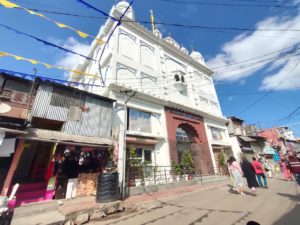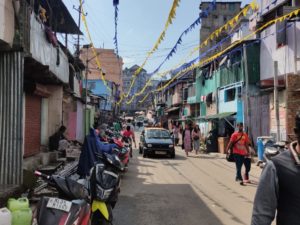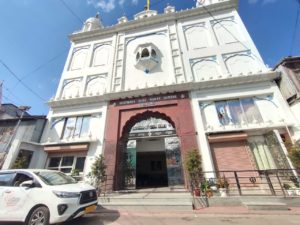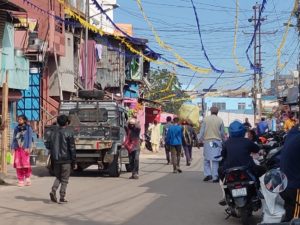Amid the ongoing political dilemma in Harijan Colony, residents pour their hearts out amidst the quandary yet exhibit resilience and jubilance observing Guru Nanak’s birth anniversary, reports Aafaque Hussain.
 The Punjabi Line or the Harijan Colony located in the heart of Shillong has been the most discussed issue in recent years ever since a clash broke out in 2018 after which the State Government and the residents of the colony are continuously engaging with each other to resolve issues of relocation. Amidst all the controversy of relocation and prevailing situation, the colony which houses over 300 residents celebrated the 555th Birth anniversary of Guru Nanak Dev Ji, the founder of Sikhism.
The Punjabi Line or the Harijan Colony located in the heart of Shillong has been the most discussed issue in recent years ever since a clash broke out in 2018 after which the State Government and the residents of the colony are continuously engaging with each other to resolve issues of relocation. Amidst all the controversy of relocation and prevailing situation, the colony which houses over 300 residents celebrated the 555th Birth anniversary of Guru Nanak Dev Ji, the founder of Sikhism.
The colony has been in the news for decades now, over repeated talks of relocating the residents to pave way for commercial projects in the area but the issue gained momentum in 2018 when a clash occurred there for which the city was put under curfew for months. Thus, Sunday Shillong sets out on a ground reportage to hear voices of the residents for a humane essence to the persisting political scenario.
Observing the Guru’s Birth Anniversary
 Since 2018, though several rounds of talks have taken place between the Government and the residents for relocation but till now the talks have not made any headway to achieve the ultimate goal. In the midst of all the dispute and uncertainty, the residents of the 12,444.13 square metres Harijan Colony observe the Guru’s birth anniversary in the Gurudwara located in the colony with religious preaching and sermons. The entire colony has also been decorated by the residents for the celebrations while a handful of security personnel continue to guard the colony at both ends.
Since 2018, though several rounds of talks have taken place between the Government and the residents for relocation but till now the talks have not made any headway to achieve the ultimate goal. In the midst of all the dispute and uncertainty, the residents of the 12,444.13 square metres Harijan Colony observe the Guru’s birth anniversary in the Gurudwara located in the colony with religious preaching and sermons. The entire colony has also been decorated by the residents for the celebrations while a handful of security personnel continue to guard the colony at both ends.
 Following the clashes in 2018, the road passing through the colony was closed for vehicular movement but recently, the road was opened once again for vehicles to ply, restoring a sense of normalcy and much needed relief to the people of the area.
Following the clashes in 2018, the road passing through the colony was closed for vehicular movement but recently, the road was opened once again for vehicles to ply, restoring a sense of normalcy and much needed relief to the people of the area.
Harijan Panchayat Committee (HPC) secretary Gurjit Singh while speaking to Sunday Shillong said that the Guru Nanak Dev Ji stood for equality of all classes of people and for all religions even as he referred the thoughts of the Guru that “neither a Hindu is bad nor a Muslim is bad, but those who are wrongdoers, are bad.“
 “We follow his teachings and during the celebrations, we engage in Prabhat Pheri, a tradition of early morning processions that involves singing, chanting, and playing instruments,” explains Singh.
“We follow his teachings and during the celebrations, we engage in Prabhat Pheri, a tradition of early morning processions that involves singing, chanting, and playing instruments,” explains Singh.
Prabhat Pheri begins in Punjab a month before the celebrations but here in Shillong, they usually do it five days before the birth anniversary of Guru Nanak Dev Ji .
“Through these Bhajan/ Kirtan, we follow his teaching and try to spread his teachings among the masses,” Singh says while adding that programmes are also organised in different Gurudwaras where preachers from Punjab come and recite religious sermons.
Expressing his joy of the inclusivity of the day, wherein not only Sikhs but people from different communities join them in the celebrations in Shillong, Singh said that they have been celebrating the festival since ages in Meghalaya by involving people from different walks of life.
Historical trajectory of the colony
Sharing in detail how the observations of the Guru’s birth anniversary commenced in a far off place like Shillong more than 150 years ago, Singh said that their ancestors have narrated to them about its history when it began in the 1860s. This was when the Gurudwara was first constructed in the colony and its structure was changed once in the 1900s and then again once in the year 1955.
“Our Gurudwara has been here for more than 150 years and we even have a temple here and the trust has been registered since 1904,” he says while showing us a photo of the Gurudwara which was taken in the 1900s.
Singh admitted that many of their ancestors were born and died in the colony itself and have a deep emotional attachment with this place and hence they are fighting this long legal battle with the Government to save their homes.
It is learnt that the Sikh community first settled in Shillong when the Sikhs who were serving in the British Army were sent here. As many Sikhs were stationed here for the British Army, they decided to construct a Gurudwara in the locality as they believe that there should be a Gurudwara in every place which was visited by Guru Nanak.
It is said that as many of the contractors in the British Army were Sikhs , they brought many labourers from Punjab for works here and apart from Shillong, many Sikhs were also brought to Assam after Maharaja Ranjit Singh Sikh Army was also sent to Assam to help the Ahom tribe fight Burmese invaders.
“ It is not that the Sikhs were brought here for cleaning jobs,” he states.
Turmoils of the present
Admitting that a narrative has been created in the last 5-6 years by the Government in order to hasten their relocation, Singh recalls the High Court on most of the occasions has given them relief when the matter pertaining to relocation has reached the Courts.
“We have been staying here for years and it was the Government which gave us land and we have every right to live here,” he claims even as he added that the Syiem of Mylliem gave them a document that they have been living here even before 1863, during British rule.
Referring to the move of the Meghalaya government to take possession of the land at Iew Mawlong after paying a premium of over Rs 2 crore to the Syiem of Mylliem, he said that the land was transferred bypassing every process and if they challenge the same in the Court, the move of the Government will not last in the Court.
“If they have a proper settlement, we are ready for relocation,” says a self-defeating and teary-eyed Singh.
Recalling the memories of his childhood, Singh said that their lives will be changed forever if they are relocated and added that they there are many memories with this place which is located at the centre of the Shillong
“We will be devastated if we relocate and we expect many challenges along the way, if and when that happens” he says while adding that their request from the Government is also to provide a livelihood for 60 existing shops in the new proposed project which the Government is planning in the area post their rehabilitation.
“The shopkeepers should be allowed to own some shops in the project or else they will be jobless but the Government has not relented yet,” he pleads.
The residents maintain that the narrative about the community and the place has taken a sharp turn in Shillong as earlier they were seen as hardworking people with a lot of respect but in the last few years, the residents say that this perception has been changed through a negative campaign floating against the community.
The residents expressed a sense and feeling of dejection as their lives have transformed for the better. Citing an example of the growth in literacy rates, they admitted that though the literacy rate in the colony was quite low previously, in the last 20-25 years the situation improved. Many of their children from the locality have even gone on to join the army and many of them have procured jobs in corporate companies of India’s top metropolitan cities.
After talking to an elderly, we also met with Sangam Singh, a youth from the locality who is currently working in an automobile company as a Sales Executive in Shillong. Sangam Singh says that the Guru’s Birth anniversary is being observed in Shillong with religious harmony and though there is a little bit of fear after the 2018 episode, the District Administration has supported them every time in its successful execution.
He recalled that their lives have changed after the 2018 clashes as they fear moving around freely in many localities of Shillong. “Earlier we would visit many places and it was all good but after the clashes, we are called names and looked down upon, and are talked down for wearing the turban. These are perhaps perceived as small and trivial things but it does affect us mentally,” says Singh.
He says that incidents take place time and again, but they have imbibed teachings of their Guru and let it pass to avoid any confrontation.
Explaining his attachment with the colony, the youth says that they’ve spent their entire childhood in the locality playing on the streets and studying in the colony itself witnessing changes in the colony including improvement in living standards. When asked about relocation plans, like others living in the area, Sangam Singh, too, wants a resolution to the ongoing issue.
The one thing that Sangam Singh desires to witness unchanged is the Gurudwara. “But we have our sentiments with the Gurudwara. We don’t want the Gurudwara to be dismantled to save our homes,” he adds.
Amidst all the parley and contention, what is clear from the ground is that the residents of the colony are desirous of peace. They uphold the teachings of their Guru – equality, justice and brotherhood irrespective of whether they are relocated or not from this plot of land that the residents of the colony call their home.



